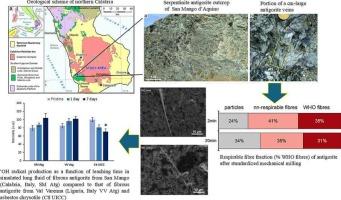Naturally occurring asbestos in Southern Italy: Geological and mineralogical investigation of fibrous antigorite from Calabrian serpentinites in view of its hazard assessment
IF 8
1区 环境科学与生态学
Q1 ENVIRONMENTAL SCIENCES
引用次数: 0
Abstract
In the last few decades, non-occupational asbestos-related diseases have been documented in populations living near naturally occurring asbestos (NOA) sites, including regions in Greece, Cyprus, China, New Caledonia, Turkey, and Italy. This highlights the critical need to assess geological and environmental hazards associated with NOA. Fibrous antigorite, among the >400 naturally occurring fibrous minerals, has emerged as a potential health and environmental hazard. This work examines the morphometrical, mineralogical and surface properties of a fibrous antigorite vein from a serpentinite body at San Mango D'Aquino (Calabria, Italy), relevant to assessing its potential toxicity. The geological site, described through field and petrographic analyses, was selected as representative of serpentinites outcropping over a large area in central Calabria. Results on the morphometric variation induced by a standardized mechanical stress, mineral solubility, and surface chemical reactivity indicated that: i) the fibrous morphology, expressed as % of WHO (World Health Organization) fibres, was largely preserved and consistent with asbestos standards; ii) antigorite fibres have a durability higher than chrysotile and close to a previously characterized fibrous antigorite from Val Varenna, Italy; iii) fibres showed a remarkable redox reactivity, even higher than chrysotile, suggesting that they may promote particle-derived radical imbalance in vitro and in vivo. Our findings revealed that the antigorite fibres from San Mango possess several critical properties commonly associated with asbestos toxicity. On this basis, we identify the NOA site of San Mango as a potential emission source of hazardous antigorite fibres, with significant environmental and public health implications for the surrounding communities.

意大利南部天然石棉:根据其危害评估,对来自卡拉布里亚蛇纹岩的纤维状反长花岗岩进行地质和矿物学调查
在过去几十年里,在居住在天然石棉(NOA)场所附近的人群中,包括希腊、塞浦路斯、中国、新喀里多尼亚、土耳其和意大利等地区,记录了与石棉有关的非职业疾病。这突出了评估与noaa有关的地质和环境危害的迫切需要。纤维反长花岗岩是400种天然纤维矿物之一,已成为一种潜在的健康和环境危害。本研究研究了意大利卡拉布里亚San Mango D'Aquino蛇纹岩体中纤维状反长石脉的形态、矿物学和表面特性,并对其潜在毒性进行了评估。通过野外和岩石学分析描述的地质地点被选为卡拉布里亚中部大面积露头蛇纹岩的代表。标准化机械应力、矿物溶解度和表面化学反应性引起的形态变化结果表明:i)纤维形态(以世界卫生组织(WHO)纤维的百分比表示)在很大程度上得到了保存,并符合石棉标准;ii)反长辉石纤维的耐久性高于温石棉,接近意大利Val Varenna先前表征的纤维性反长辉石;Iii)纤维表现出显著的氧化还原反应性,甚至高于温石棉,表明它们可能在体外和体内促进颗粒源性自由基失衡。我们的研究结果表明,来自San Mango的反长辉石纤维具有几种通常与石棉毒性相关的关键特性。在此基础上,我们确定San Mango的noaa场地是危险反长花岗岩纤维的潜在排放源,对周围社区具有重大的环境和公共卫生影响。
本文章由计算机程序翻译,如有差异,请以英文原文为准。
求助全文
约1分钟内获得全文
求助全文
来源期刊

Science of the Total Environment
环境科学-环境科学
CiteScore
17.60
自引率
10.20%
发文量
8726
审稿时长
2.4 months
期刊介绍:
The Science of the Total Environment is an international journal dedicated to scientific research on the environment and its interaction with humanity. It covers a wide range of disciplines and seeks to publish innovative, hypothesis-driven, and impactful research that explores the entire environment, including the atmosphere, lithosphere, hydrosphere, biosphere, and anthroposphere.
The journal's updated Aims & Scope emphasizes the importance of interdisciplinary environmental research with broad impact. Priority is given to studies that advance fundamental understanding and explore the interconnectedness of multiple environmental spheres. Field studies are preferred, while laboratory experiments must demonstrate significant methodological advancements or mechanistic insights with direct relevance to the environment.
 求助内容:
求助内容: 应助结果提醒方式:
应助结果提醒方式:


